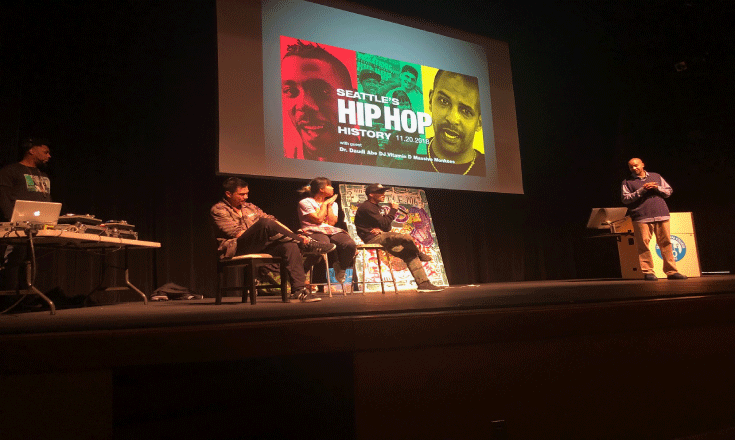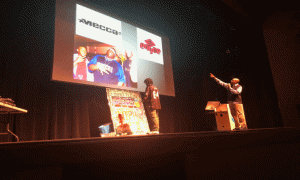
Photo Credit: Ruth E. Contreras
A Lesson in Hip Hop with Dr. Abe
Written by Ruth E. Contreras, 11/22/2018
“I am glad that I grew up around the time that Hip Hop was forming”, Dr. Daudi Abe
Seattle’s Hip Hop History goes beyond just rap music, as I learned today in the Hip Hop History forum at Broadway Performance Hall. Dr. Daudi Abe appeared along with DJ Vitamin D, Massive Monkees, B- Boy Fever One of Rock Steady Crew, and graffiti writer Malcom-X.
There is a rich history and cultural influence that goes back as far as 1858 of how the foundations for local Hip Hop culture were created, when the first African-American resident Manuel Lopes arrived in Seattle. Soon after his arrival, he opened up a restaurant and became one of the first barbers in the city.
Lopes was followed by William Grose (Gross) In 1861, who also opened a restaurant and hotel called “Our House,” and later added a barbershop on Yesler Way. Due to racist laws in other states, barbershops and restaurants were often the only businesses operated by black entrepreneurs in Seattle. Grose’s hotel would provide occupancy for many African-American laborers.
After his success in 1882, William Grose purchased 12 acres of land on East Madison Street and would sell lots to other successful African-Americans. Regarded then as North East Seattle, we know it today as the Central District (CD). This was the first middle class community for African-Americans, with the educational piece eventually becoming James A. Garfield High School.
After World War II, the local population of Blacks increased from 4,000 in 1940 to over 16,000 by 1950, including a young jazz singer named Ray Charles. He arrived soon after the war looking to become a part of Seattle’s already world-famous Jazz scene and eventually earned international success, becoming one of the pioneers of the rhythm and blues genre. “Seattle is the town where I made my first record. And if you ever want to say where I got my start you have to say right there, you have to say that. Because that was the thing that got me known.” – Ray Charles referring to Rocking Chair. Seattle Times, 2004
In 1943, Quincy Jones and his family moved to Seattle from Chicago. At age 14, Jones, a student at Garfield High School, became part of the jazz scene and met Ray Charles. Upon graduation he attended one semester at Seattle University before transferring to Berklee College of Music in Boston. Jones went on to become one of the most successful producers, composers, musicians, and film producers in entertainment history, winning a total of 27 Grammys with 79 nominations. He is also the man responsible for producing Off the Wall, Thriller and Bad by Michael Jackson.
A local native and another graduate of Garfield High School, Jimi Hendrix joined the army soon after graduation. After leaving the army and going to England to begin his musical career, on August 18, 1969 Hendrix headlined the Woodstock Festival in Bethel, New York, where he unveiled his groundbreaking rendition of “The Star-Spangled Banner” on his electric guitar.
Sports was also a big influence. At a time when many football coaches refused to play African-Americans at quarterback, University of Washington coach Don James gave Warren Moon an opportunity. Moon led the Huskies to a Rose Bowl victory over Michigan in 1978, earning MVP honors. Even after his college success Moon was not selected in the NFL draft, and instead went on to play for the Edmonton Eskimos of the Canadian Football League, winning 5 Grey Cups, the CFL version of the Super Bowl. Moon eventually played for several NFL teams, including the Seahawks, and in 2006 became the first African-American quarterback elected to the Pro Football Hall of Fame.
The history of local Hip Hop goes back almost four decades, with the arrival of the first successful mainstream rap single “Rapper’s Delight” in 1979. Very soon after, Seattle was creating its own unique sound and scene. In 1981 a Filipino-American DJ named “Nasty” Nes Rodriguez began hosting a show called “Fresh Tracks” on KFOX, which was the first rap radio show on the West Coast. Soon Nasty Nes met another rising local artist, Anthony “Sir Mix-A-Lot” Ray, and began airing Mix-A-Lot’s music on KFOX.
“If it wasn’t for that a lot of us would not be Djaying that’s fo sho.” – DJ Vitamin D, speaking about hearing Sir Mix-A-Lot scratching live on the radio in the early 1980s.
The Emerald Street Boys were one of the first local rap groups to make some noise in the local community. Sugar Bear, Captain Crunch and Sweet J incorporated elaborate choreographed dance routines along with their raps. Together with the Emerald Street Girls, the groups would perform around town and open for national acts like the Treacherous Three. The Emerald Street Boys became the first Seattle Hip Hop artists to make a record, which was called “The Move” b/w “Christmas Rap.”
“In the fall of 1988, after graduating from Garfield High School, I was in the Bay Area for College at a party and I don’t remember what song was playing but no one was digging it because the dance floor was empty. Then I hear the opening beat to ‘Posse on Broadway’ and I thought, ‘I understood Sir- Mix- A lot to be a Seattle guy, why is this playing down here?’ As soon as the song started playing, hands went up in the air and the dance floor was packed. I was shocked both by the fact [that] the song was playing and [that] everyone seemed to love it. In addition to that, once I started meeting people down there who listened to rap and found out I was from Seattle, I would get questions like, ‘What’s Broadway like?’ and ‘Are the burgers at Dicks good?’ Hearing people who had never been to Seattle ask about these kinds of details helped me really understand the power of Hip Hop to export elements of local culture to other places; because those people wouldn’t have known any of that without a song like ‘Posse on Broadway.’ – Dr. Daudi Abe, speaking about his first encounter with hearing local rap music outside of Seattle.
Sir Mix-A-Lot went on to win a Grammy Award for “Baby Got Back” in 1993 over fellow nominees Queen Latifah and Marky Mark (yup Mark Wahlberg), putting Seattle on the Hip Hop History Map. This was followed by Digable Planets, led by Garfield grad Ishmael Butler, claiming a rap Grammy in 1994 for their song “Rebirth of Slick (Cool Like Dat)” in 1994. Among the nominees that year was “Ain’t Nothing But A G Thang” by Snoop Doggy Dogg and Dr. Dre.
Local media also played a role in the push for the up and coming Hip Hop scene. In the 1980s, The Rocket was among the first media publications to regularly cover local artists in print, followed by Flavor magazine in March, 1992. Although Flavor was publishing local artists on their covers, they received backlash. It had a readership of about 10,000 per issue and was distributed at no charge in the U.S.A , England and other places in Europe. Music Inner City premiered in 1990 on Seattle’s community access television network. Then Georgio Brown began Coolout Network, becoming the documentarian for the local Hip Hop Culture. In the late 90’s, SeaSpot Magazine was created and at the cusp of the internet he created SeaSpot.com., generating more internet traffic than the Seattle Times.
Clothing is one of the staples in the Hip Hop Community. Two fellow natives Lando Felix, and Tony Shellman from the Madrona area created a fashion line called Mecca along with a third partner, Evan Davis. Their first major endorsement was by rapper Biggie Smalls (Christopher Wallace). They left the company that produced MECCA and started another brand named Enyce; which did so well it was acquired by Liz Claiborne Company for $120 million U.S.D. The new company, not knowing what to do with an urban brand, ended up selling it to Sean Combs (P.Diddy).
Then we have more influencers like local Dj Vitamin D ,who, amongst other attributes, created the theme song for the TV show Power. Along with Jake his protégé, he has done work with rappers like Drake, Rick Ross and has been nominated for several Grammy awards for his production work. Macklemore and Ryan Lewis are also local and prominent artists, winning 4 Grammys and 1 Grammy nominee. Laura Peace Kelly is a Spoken Word artist who appeared on Def Poetry performing in the Central District. The late and great Jonathan Moore was an artist and local activist. The late Leah Labelle was signed to I Am Other, Epic, and So So Def. The Blue Scholars were another local group, along with Porter Ray, who was recently signed with Sub Pop Records. Young Lennox a young kid who has done crayon renderings of classic vinyls, has had his art displayed in Gallery in New York City and Los Angeles.
The 206 Zulu, a local division of the Zulu Nation which was created by Afrika Bombata and Africa Town Central District, are one of the community pillars for the Seattle Hip Hop Community. Carter aka Fever One, a local native from Seattle, went on to become a member of the Rock Steady Crew in New York. After his success, he came back home and created a space where other teens can express their art through Hip Hop at the Jefferson Community Place. Carter became the mentor to a kid we know today as the Co-Founder of Massive Monkees Jeromski. After Massive Monkees’ whirlwind success, they came back to Seattle and opened a studio to teach women how to battledance, led by Anna Banana.
Through the hard work and efforts of local organization 206 Zulu, on October 24th, 2014 Governor Jay Inslee of the state of Washington proclaimed that November is Hip Hop History month statewide. Expressing yet again that Hip Hop is more than music. It’s a form of expression that fosters a sense of community, culture, language, and art; where you can recreate or reinvent. That, to me, is Hip Hop.


